
How do users feel about your brand?
Understanding this user sentiment is key to growing and maintaining an effective online presence for your organization. At CableTV.com, we faced a branding dilemma—despite our name, our site was focused on helping customers find providers for not only cable TV, but internet and streaming services as well.
Additionally, as traditional cable TV itself continues to be crowded out by streaming and other entertainment options, our name and brand were at greater risk of becoming obsolete.
To help our team better understand how to solve these issues, I conducted 1st click testing and user interviews to uncover insights into how users perceive the CableTV.com (CTV) brand when conducting searches for internet providers.
CableTV.com Brand Identity Project Overview
Role
- UX Researcher
- UX Analyst
Process
Tools Used
- Google Search Console
- Crazy Egg
- Lyssna
- Zoom
- Figma
Pssst — if you're into spoilers, you can jump straight to the bottom line of this project.
The Problem to Solve
For customers seeking internet providers, we were concerned that our CableTV.com name was a major deterrent to attracting clicks from search engine results pages (SERPs). These users may never see us in the SERPs; if they do, they may ignore us because of our name appearing irrelevant or untrustworthy given their search intent.
This testing sought to begin exploration of this challenge by uncovering insights into how users perceive our brand when conducting searches for internet providers. By understanding how users felt about our brand, we would know if any changes needed to be made to better connect with our audience.
Preliminary Data Gathering
User Surveys
Before creating a test plan, I gathered initial data to help support my hypotheses and justify the need for doing this testing. I ran a survey across nine geo pages (pages for a specific U.S. city, which list internet and TV providers in that area) asking users what type of service they were looking for.
Cable TV service was the top response, at 43%, followed by TV/internet packages. Internet service came in third.
These initial results indicated that only a minority of users landing on our geo pages were searching for internet-only service. Presumably, the majority of users seeking internet-only services were either not finding CTV or were choosing to go to competitor sites instead.
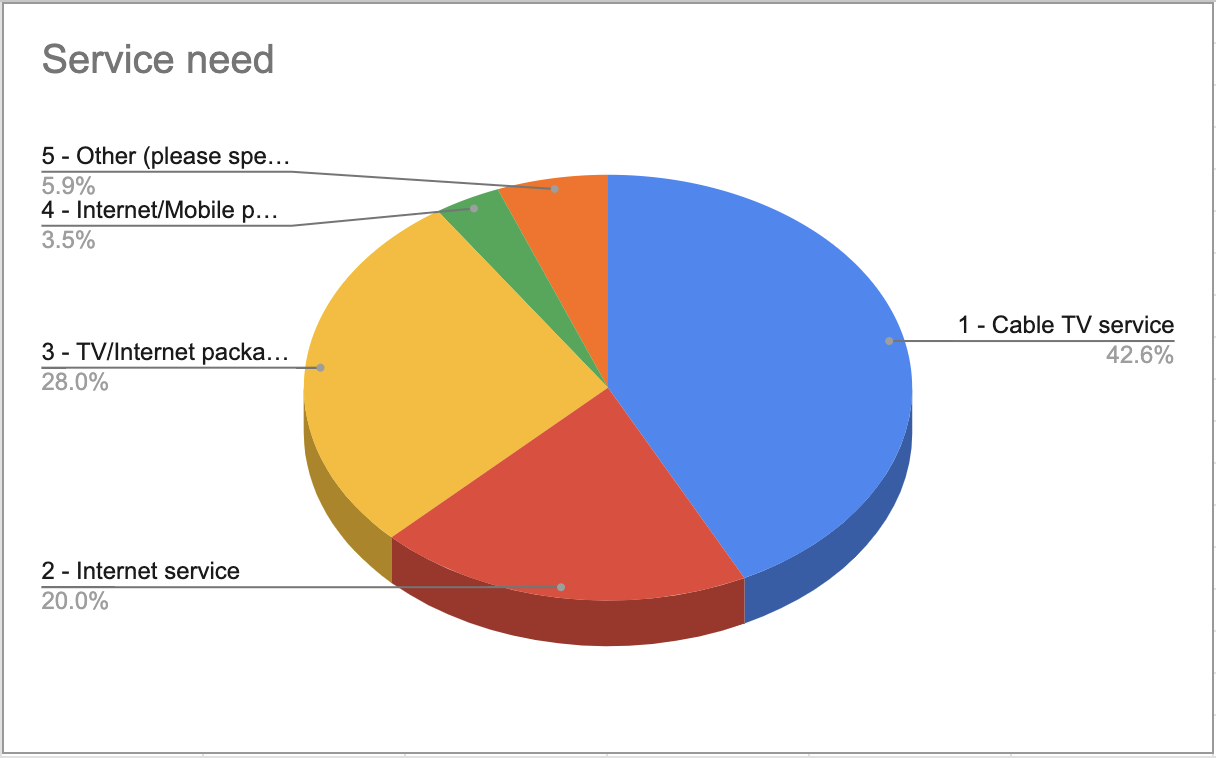
Google Search Console Queries
Data from Google Search Console further demonstrated that the majority of queries leading users to CTV were not related to internet or internet provider-related search terms.
The top 12 queries were cable, TV, or streaming-related topics (see accompanying screenshot).
The first query containing the word internet was 31st in the list.
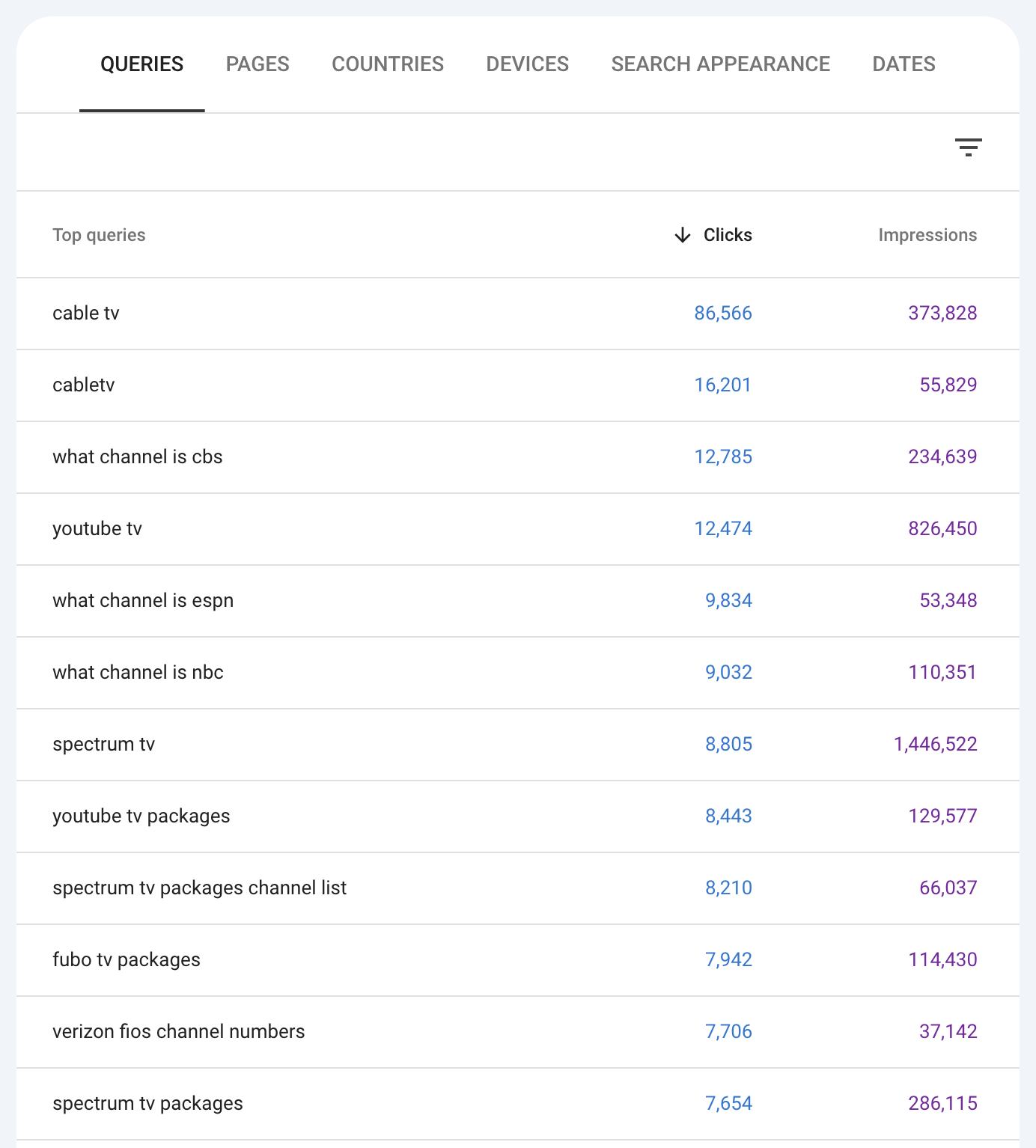
1st Click Testing
The first phase of the brand identity project was to determine how users perceive the CTV brand when exposed to it within the most common scenario for first-time site visitors—a snippet from organic search engine results.
1st click testing is a simple but powerful testing method to see where users choose to click first when presented with a mockup of a particular web page, screen, or other type of design. Often it is used to confirm if users are attracted to the correct primary CTA.
Because we were interested in which result users most often select first from a SERP page, I used 1st click testing to present a hypothetical Google SERP page displaying results for internet comparison sites. Conducting this testing using the 1st click method (rather than a live website) allowed me to manually manipulate the ordering of the SERP results in order to test different ranking scenarios.
Round 1: CTV ranked #1
For round 1, CTV was deliberately placed in the top SERP position. While this positioning would not occur in a real-world scenario (when using internet-only keywords), the goal was to see if a #1 ranking would be enticing enough to steal clicks from sites with more relevant-sounding, internet-focused domains.
Users were given the following prompt and shown an image of a Google SERP listing internet comparison sites.
Imagine you are searching on Google to compare internet providers in Los Angeles and are presented with the following results. Which result would you click on first in your search for the best internet provider?
After making their selection, users were asked to explain their choice of which website to visit first.
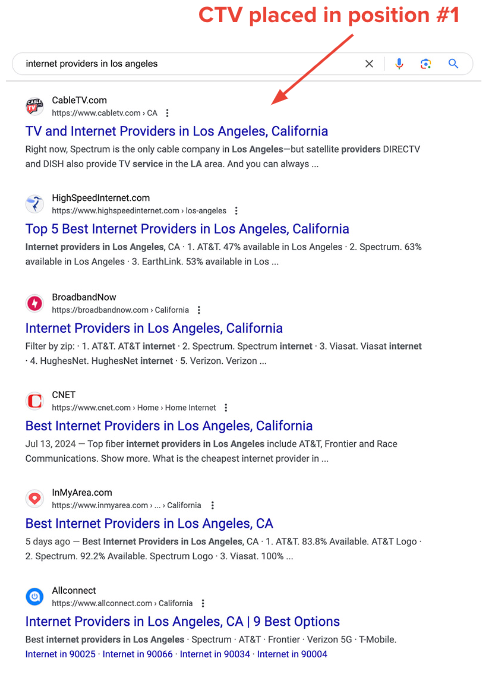
Results — Round 1
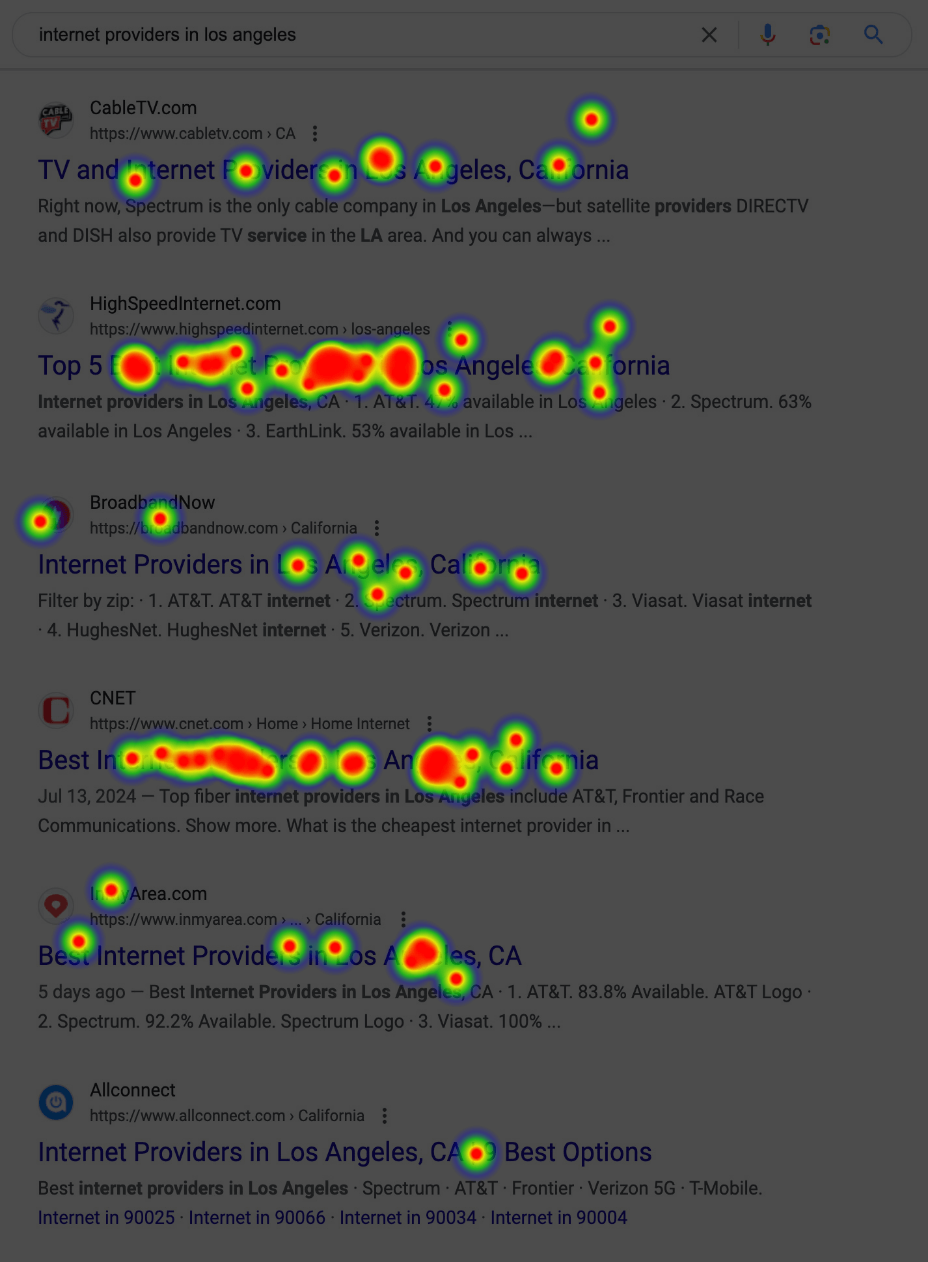
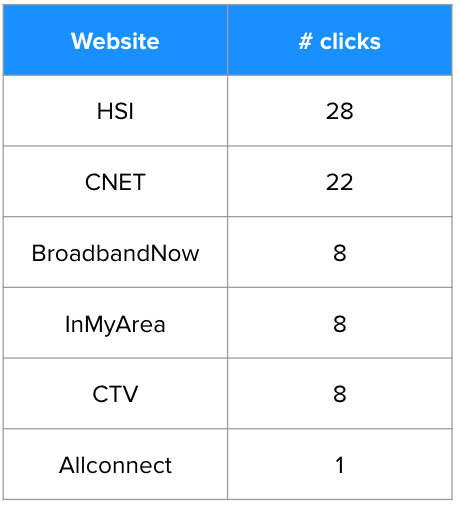
Reasons users gave for selecting which site to click—common themes:
HighSpeedInternet
- “Best” used in title
- “Top 5” used in title
- Relevant website name
CNET
- Trusted, well-known brand
- Relevant description snippet
InMyArea
- Highly relevant name
- Recent date listed in snippet
CTV
- Listed first in SERP image
- “Seems like” a good choice*
*No clear reason given for this. Likely due to #1 position in SERP.
Round 2: CTV ranked #3
The results from round 1 indicated the 8 clicks on CTV were based solely on its #1 ranking. For round 2, I moved CTV to SERP position #3 to see if any users would still choose to click on it, given its lower ranking.
Users were given the following prompt and shown an image of a Google SERP listing internet comparison sites.
Imagine you are searching on Google to compare internet providers in Los Angeles and are presented with the following results. Which result would you click on first in your search for the best internet provider?
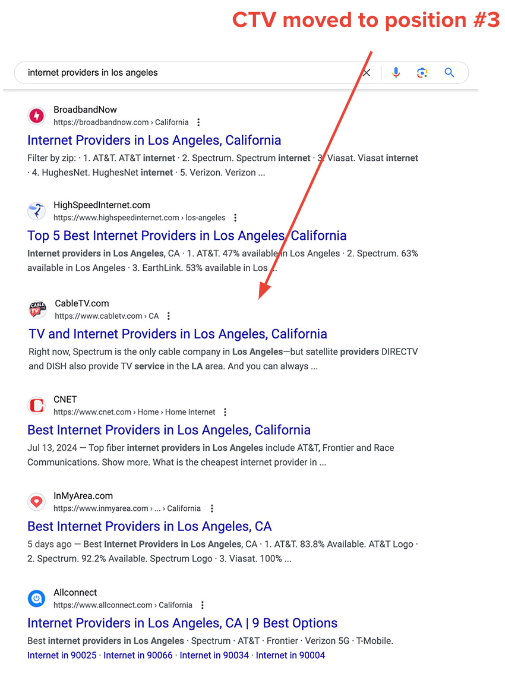
Results — Round 2
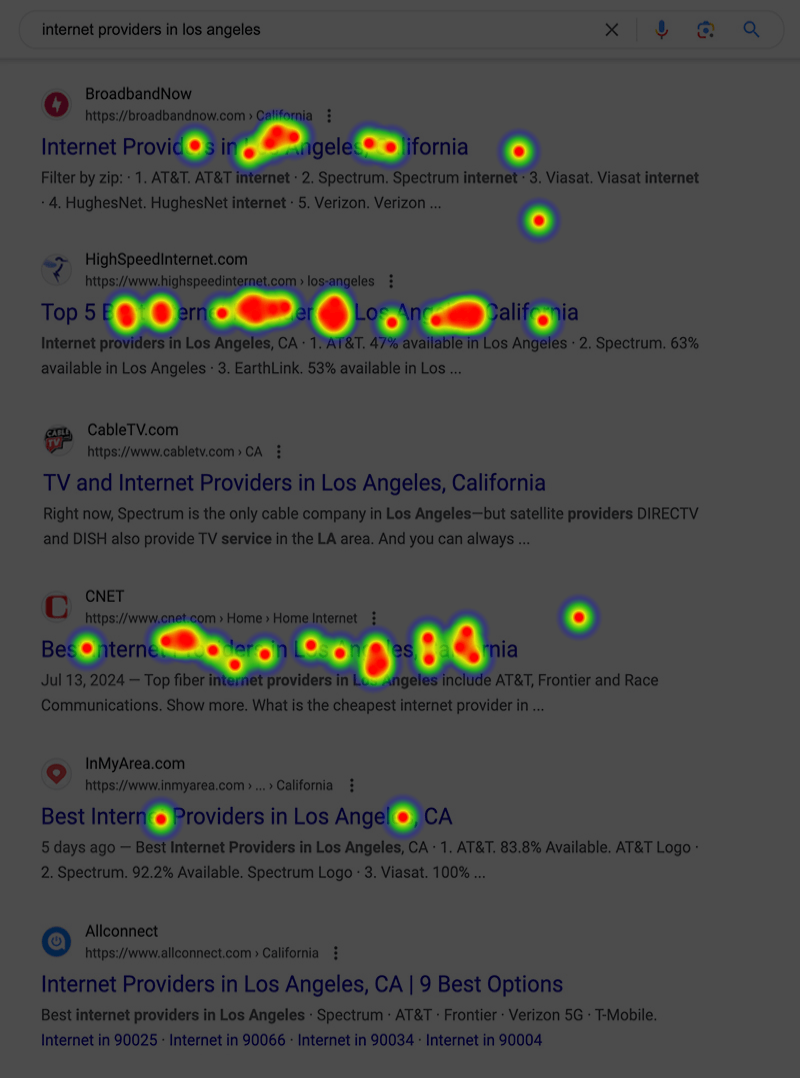
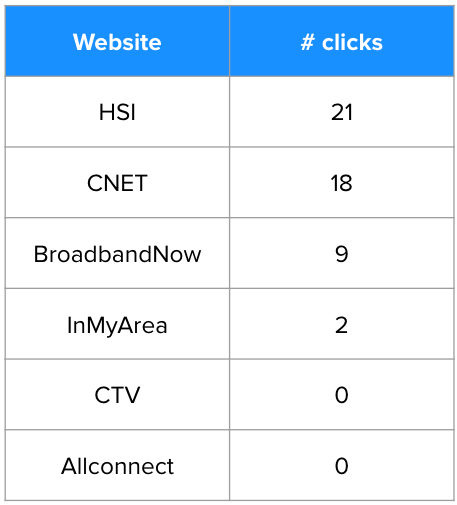
Click Test Results — Totals of Round 1 + 2
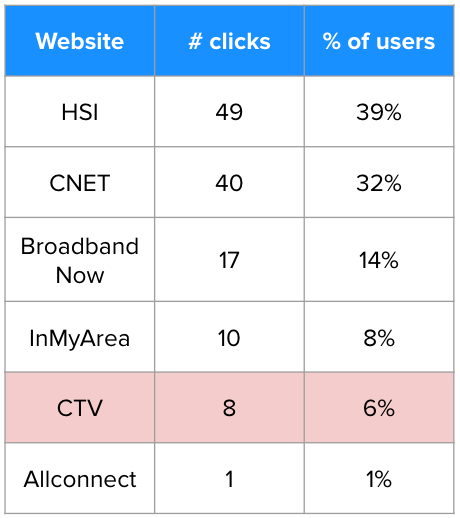
- In total, only 8 of 125 (6%) users chose to click on CTV as their first choice when choosing an internet comparison site from the SERPs.
- All 8 clicks came from the SERP example listing CTV in the #1 slot (unrealistic in a real-world scenario).
- Of these 8 users who selected CTV, 4 users stated explicitly that the reason was due to CTV being ranked 1st in the results.
- The remaining 4 did not give clear reasoning, simply explaining that it “seemed to be” the best choice—likely, the #1 ranking subconsciously influenced this assessment.
Round 3: Click test follow-up question
The final step of the click test was a direct ask about user sentiment toward the CTV SERP listing.
Users were given the following prompt and shown an image of a Google SERP revealing only the CTV snippet, along with a 1 to 10 scale rating option.
Imagine you are searching on Google to compare internet providers in Los Angeles and are presented with the following result for the website CableTV.com.
How likely would you be to click on this result to visit CableTV.com in your search for the best internet provider?

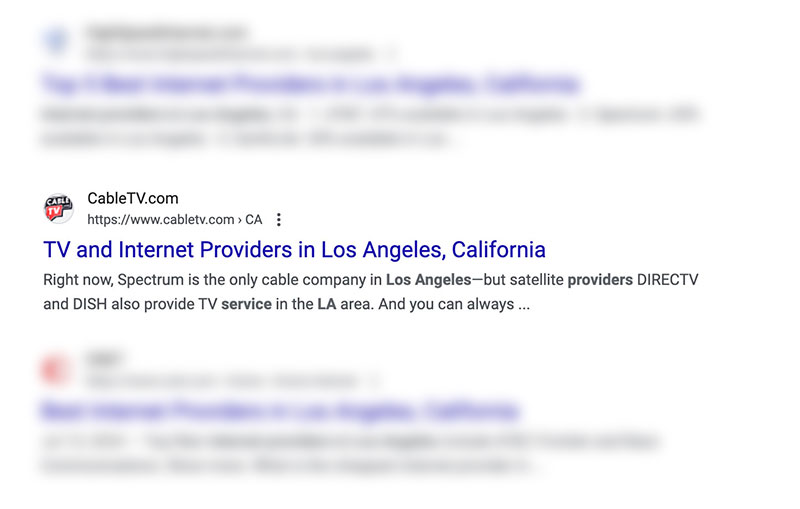
After making their selection, users were asked to explain why they chose that rating.
Results — Round 3
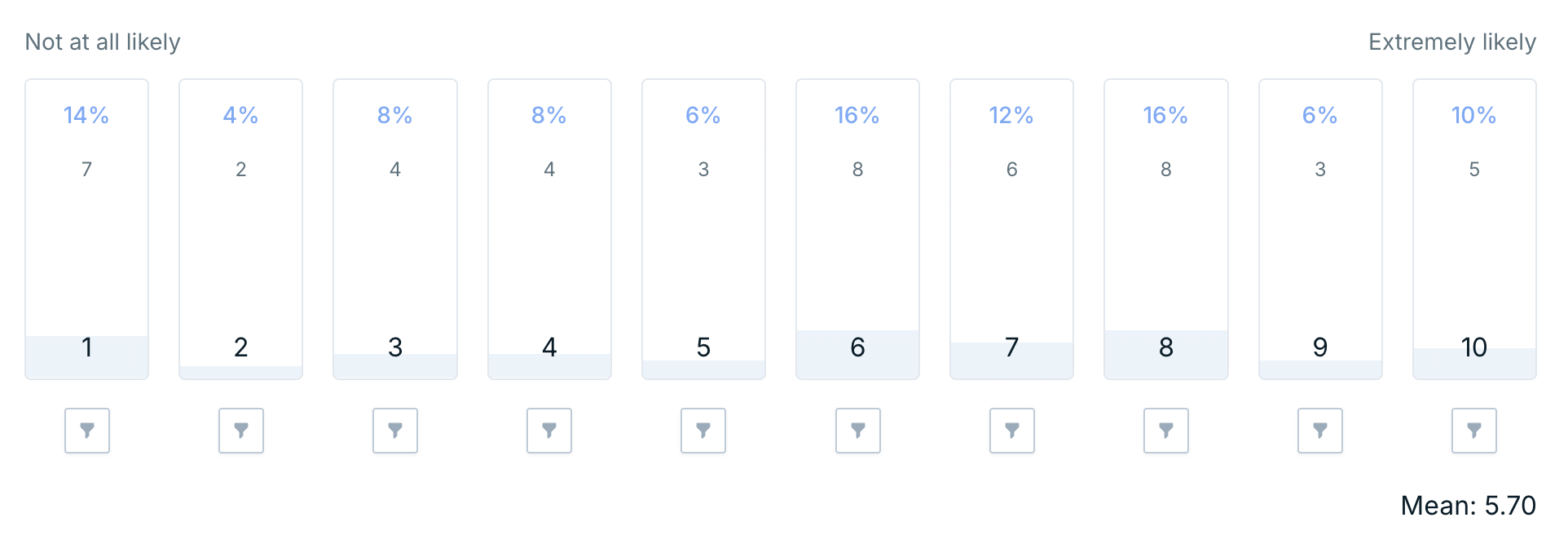
Positive comments (high likelihood of visiting CTV)
Users who indicated a high likelihood of visiting CTV gave various reasoning, such as:
- “The small description and headline seem to match what I am looking for.”
- “It appears to be non-biased website providing info on many ISPs in LA”
- “Because cableTv.com seems to be professional on provision of TV and internet service”
- “It has what I am searching for and looks credible.”
- “I like to have all my options available in one place. I do not want to have to do different web searches.”
- “It's straightforward and very clear. Seems like it's going to get me what I want!”
Negative comments (low likelihood of visiting CTV)
For users indicating a low likelihood of visiting CTV, the reasoning fell broadly into two categories: the words “cable/TV” being in the name, and the appearance of the site as being unfamiliar, spammy, or untrustworthy. Examples include:
Cable/TV in name
- “I’m not looking for cable, I want info about internet service”
- “Name of the website itself is confusing. Why would I click on the site which has a name CableTV for internet plans?”
- “I feel that the website will be more focused on TV subscriptions and not as much on internet services.”
- “If searching for internet, the supportive text under the headline only mentions TV service not internet so not interested”
- “I have never used cable tv in my adult life. I only watch streaming services.”
Unfamiliar/untrustworthy
- “Never heard of them”
- “Haven't heard of it before and it looks like it could be a spam”
- “This looks a bit spam-ish like it is collecting information from you that it shouldn't be.”
- “It feels gimmicky and I don't trust the provider. I feel forced into using the "only" cable company in LA.”
- “I would think to look for some of the larger well known companies, this seems like a little bit of a sketchy link.”
- “It seems a little bit sketchy. You never know what the site will be on those types of searches.”
Click test follow-up question — key takeaways
Negative sentiment 👎
→ Nearly every negative sentiment to the CTV result was due to the name (mismatching intent of searching for internet), lack of familiarity with the brand, or the appearance of being spam/clickbait.
→ The spam concerns are likely due to the unknown nature of the brand, the mismatched result (cable TV as opposed to internet), the perception of cable TV being an outdated or gimmicky medium, the confusing description in the snippet, or all of the above.
Positive sentiment 👍
→ The positive sentiments were mostly due to headline/description containing enough keywords to appear relevant, and the understanding that the site would be a helpful guide for comparison shopping.
→ It’s important to remember that the high scores were given from users viewing the CTV result in isolation, in which they did not have more enticing options available. As seen from round 2, when presented with a full SERP, 0% of users chose CTV over a competitor.
Qualitative Testing — Moderated User Interviews
The 1st click testing unveiled key insights into user perception of the CableTV.com brand when encountering the site on a SERP listing. To dig deeper and learn more qualitative data on why users felt the way they did, I followed up with remote, moderated user interviews with five participants.
Test plan
Objectives
- How users choose to select an internet provider resource from a SERP page and their likelihood of selecting CableTV.com, given a query about finding an internet provider.
- Why users choose to select competitor sites from the SERPs, as well as what they like best and find most helpful on competitor sites.
- User sentiment toward the CTV name/brand/domain—do they see us as relevant, trustworthy, legitimate? Does our name hinder our authority in the internet space?
Test setup
- 40-minute moderated sessions, conducted via Zoom using the Lyssna testing platform.
- 5 participants (2 mobile, 3 desktop) recruited from the Lyssna test panel; adults located in the United States.
- Screener: participant has signed up for new internet or TV service within the past 3 months.
Test hypotheses
- We suspect that when prompted to search for an internet comparison site, users are more likely to choose a result from a domain clearly tied to internet (HSI, All Connect, Broadband Now, etc).
- We suspect that users will indicate the CableTV.com name is a hindrance to awareness and trust of our ability to be a reliable resource for internet-related searches.
Testing Scenario and Tasks
Scenario
Imagine you’re researching internet service providers hoping to find the best one for your needs.
Questions & Tasks
The test was divided into three primary portions:
- Background info (previous internet research process, most important considerations when choosing provider).
- Open search on Google for an internet provider, then assessing likes/dislikes and various aspects of whichever site the user chose to visit first.
- Targeted search query on Google to display CTV in the results; assessing user sentiment toward the CTV listing, then assessing likes/dislikes and various aspects of CTV geo page and the overall CTV site/brand.

Test Findings
Finding a local service
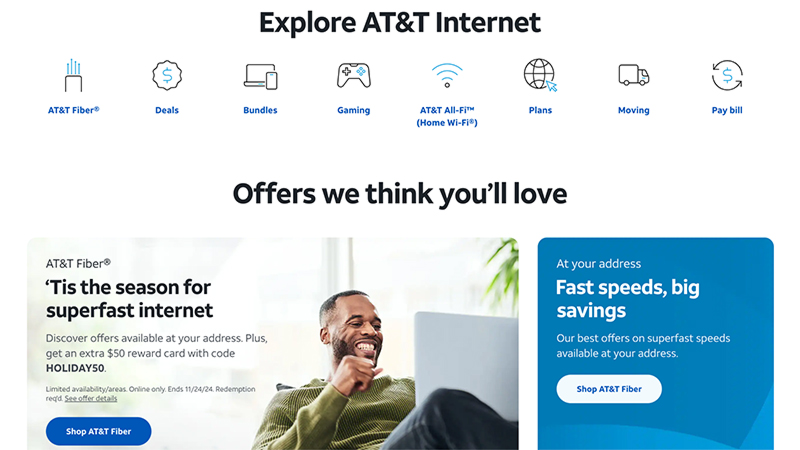
- 5 of 5 users said they would look online to search for an internet provider.
- 2 users noted they would first talk to family/neighbors to find out which providers are available.
- 4 users said they would likely begin with a general Google search, while 1 user indicated he would go directly to provider websites.
Most important considerations when choosing a provider
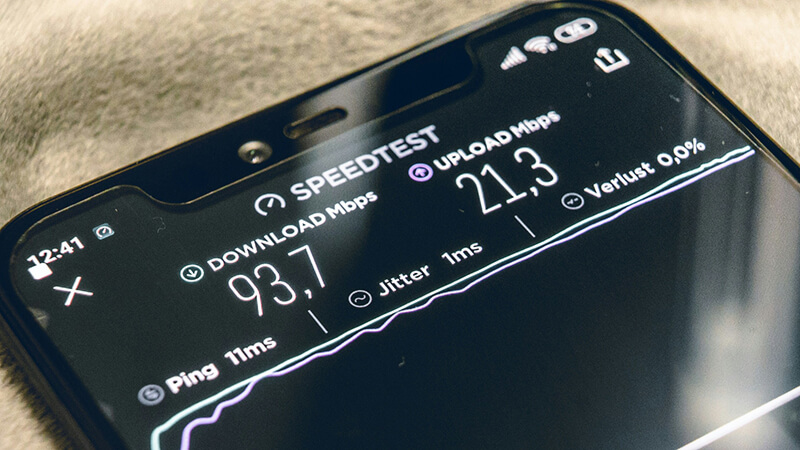
- 3 users stated that reliability was the most important factor when choosing a provider.
- 2 users stated that price was the most important factor when choosing a provider.
- Internet speed was the other determining factor mentioned as a consideration.
Open search on Google for an internet provider
- When prompted to search for an internet provider, users typed the following search queries:
- internet providers in my area
- Staten Island internet providers
- internet providers
- internet providers in Carmichael, California
- internet provider near me
- 3 of 5 users chose to click on HighSpeedInternet.com as their first click
- 1 user chose to click on the provider website for Verizon first
- 1 user chose to click on the provider website for Spectrum first
Assessing CableTV.com SERP listing and website
Likelihood of visiting CTV, based on SERP
- 3 of 5 users indicated they likely would not click on CTV because of the name seeming to be unrelated to internet; though one of these users mentioned that seeing an internet provider listed in the description might encourage her to click.
- 1 user said he likely would not click on CTV due to having never heard of it before.
- 1 user said she likely would click on CTV due to its position in the SERP and relevant description listing internet providers (for this question, CTV had a top ranking because of the specific query provided by the UX Researcher).
Rating the CTV site (1-5 scale)
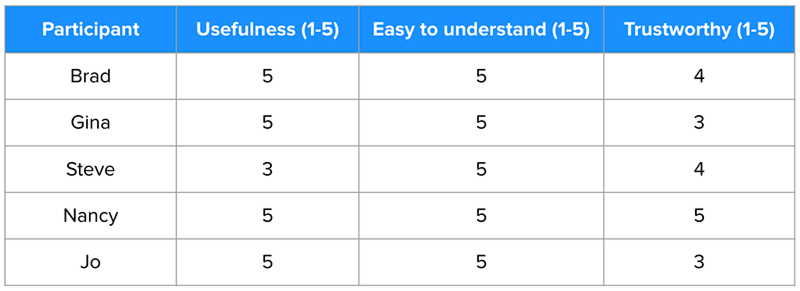
Although most participants indicated a low likelihood of visiting CTV, once they did view and explore the site, they had a largely positive impression, as seen by the ratings above.
Dislikes/negative feedback of the CTV geo page/site
- Customer ratings don’t list how many ratings it is based off; some provider cards have no rating listed.
- List of internet providers is small compared to total amount available.
- No imagery on the page (aside from logos).
- Don't know if the writers are “experts”.
- Have never heard of this site, don’t know how trustworthy it is.
Likes/positive feedback of the CTV geo page/site
- Amount of information provided (easy-to-see price, speeds, ratings, availability, etc.)
- Clarity of the information (provider cards are well-designed and easy to process).
- Tables of comparison information.
- Option to sort the results.
- Navigation menu provides avenue to more info if desired.
Two standout quotes:
“I’m curious why this page didn’t come up when I did my initial search.”
“You would think a more useful page like that would come up earlier in the search.”
—Participant 2, when assessing the usefulness of the CTV geo page
These quotes summarize the sentiments of the majority of participants: although they were unlikely to choose to visit CableTV.com from the perspective of an internet service shopper, once they did land on a CTV geo page, they found it to be a useful resource in their customer journey.
Insights and Takeaways

- Users notice not only the headline, but also the description text within SERP results. Optimizing what displays here is crucial for success.
- Depending on their exact query, there is a low probability of users finding CTV in the SERPs when searching for internet-only information.
- If a user does come across a CTV result in the SERPs, they are unlikely to click on CTV for internet-specific information if other, more relevant options are available.
- For users searching internet providers, it is justified to say that the CTV name is hindering our ability to attract clicks. However, an equal or perhaps even greater hindrance is our lack of brand recognition and perception as a spammy or questionable website.
- However, if users do choose to visit CTV, there is a strong possibility they will like what they see and will find our information on internet (and TV) providers to be a useful resource in their internet search process.
- Users follow a multi-step process when researching services. Even if we change our name, grow our brand, and improve our website, the reality is that CTV may just be one stop in the user’s journey, not the sole resource or definitive end.
Opportunities and Next Steps
Short-term / small scale
- Optimize SERP headline/description. A large number of users indicated the words “best” and “top [number]” stood out in several SERP results and were a major reason they chose to click on it.
- Optimize geo page/product cards. Indicate the # of reviews comprising a rating, hide stars if blank, provide more comprehensive list of providers, enhance aesthetics with more customized imagery.
- Split out geo pages. Separate pages for TV and Internet will allow us to best optimize for SEO and best serve users what they are looking for.
Long-term / large scale
- Name change/rebrand decision. The results show that undoubtedly, our name is a potential roadblock to many users searching for internet-only services. However, the heart and soul of CTV is not internet. How can we improve our standing as a resource for internet content while maintaining our identity as an all-things-entertainment brand?
- Brand recognition. Growing our brand and becoming a well-known, trusted resource will go a long way in gaining the trust of users. How can we become a known brand like CNET?
- Trust and credibility. Many users see our current brand as sketchy, spammy, or gimmicky. How can we address this?
The Bottom Line

The testing and user interviews revealed that the CableTV.com brand was at a significant disadvantage of attracting discovery and clicks from internet-seeking customers.
Based on my findings, the CTV team was able to immediately assign their SEO Strategist to work on optimizing the SERP headlines and descriptions, while the editorial team began assessing ways to improve the listings on internet product cards.
The results were also eye-opening to the senior leadership team, who realized the vital need to improve and promote CTV's brand.
Questions? Email me at nathanbrown.ux@gmail.com.
